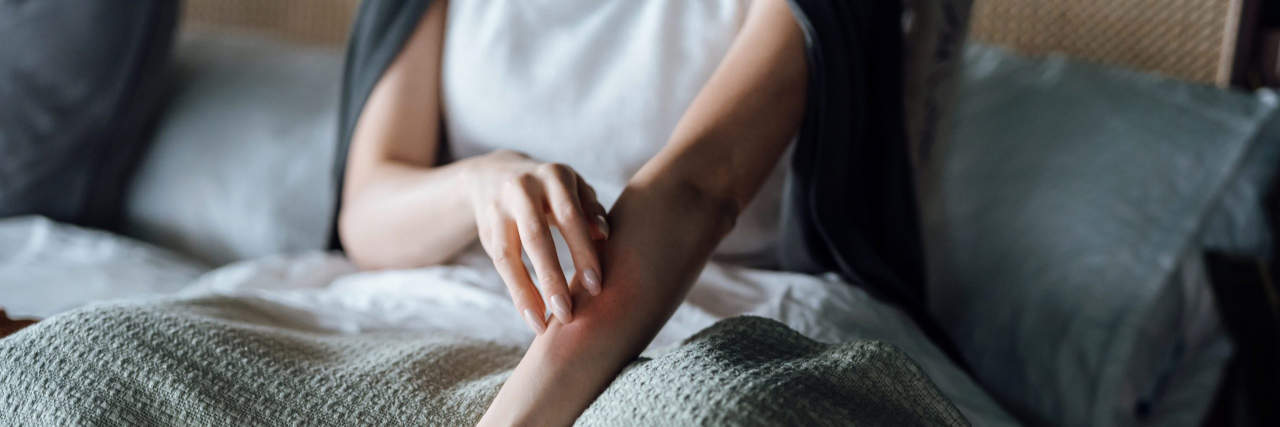Itchy skin is never comfortable. But for people with cholestatic pruritus caused by Alagille syndrome (AGLS), it can be a constant, potentially distressing companion. Thankfully, there are some things to try, in addition to medications that a doctor may recommend, that could help relieve discomfort.
AGLS is a genetic disorder that occurs when the liver develops with too few or misshapen bile ducts. Bile ducts are small tubes that allow bile, a digestive enzyme, to pass from the liver into the small intestine. A genetic defect in a gene called Jagged1 is thought to be the cause of AGLS.
When bile cannot properly move through the body, it backs up into the liver (cholestasis) and enters the bloodstream where it stimulates nerves and causes itching (pruritus). According to research published in Current Hepatology Reports, cholestatic pruritus is common, affecting up to 70% of patients with immune-mediated liver disease. It can be life-changing and is important to discuss with your doctor. According to one study:
“Chronic pruritus can cause severe sleep deprivation and exhaustion, resulting in fatigue, depression, and even suicidal ideas.”
In a personal letter to Alagille syndrome, Mighty contributor Kristen Baugher shares what living with cholestatic pruritus from AGLS is like for her daughter.
“[AGLS] created an invisible pain itching in my daughter’s body that causes day-and-night suffering.”
If you or your child are living with cholestatic pruritus due to AGLS, a few ideas to try and combat the itch include:
Medications
According to the Childhood Liver Disease Research Network, a build-up of bile salts is primarily responsible for causing the itchy sensation. Some medicines work to clean bile salts out of the body. Antihistamines generally do not work well to actually block the itch associated with cholestatic pruritus, but they can bring on sleep, which provides relief.
Keep fingernails short and clean
It is inevitable that eventually an itch will need to be scratched. To avoid breaking the skin, trim fingernails short and keep them clean to prevent infection.
Encourage rubbing instead of scratching
If at all possible, attempt to rub the itchy area first with fingers or the palm of the hand to relieve the itch sensation before scratching with fingernails.
Moisturize the skin
The use of lotions, especially emollients, is important to prevent dry skin from contributing to itchiness. Also be sure to put lotion on skin directly after showering or bathing when skin is still moist, to trap hydration.
Use soapless, lukewarm, or cool water for bathing
Bathing can strip away the skin’s naturally lubricating oils. The hotter the water the faster this process happens. Use the coolest water your body can tolerate and follow up with moisturizer.
Use a cool compress to relieve itch
A cloth soaked in cool water placed on an itchy patch of skin can settle nerve endings and help relieve the itchy sensation. Menthol has the same effect and some over-the-counter anti-itch creams may be effective.
Dress in loose, cotton clothing and avoid wool and polyester
Some clothing is known to be rougher against the skin and may aggravate itching. Stick with loose, comfortable, lightweight clothing, preferably made of cotton.
Find activities that distract from the itching and make you tired
It may be a favorite activity, or a toy or friend for a child, but try to engage with activities that will take your mind off the need to scratch. Preferably things that will keep you busy and help wear you out during the day so that it is easier to sleep at night.
Use socks to protect hands at night
To avoid scratching at night, place socks over hands or sew them onto children’s pajamas sleeves.
Keep the temperature cool and humidity moderate
Heat can exacerbate itching so keep the temperature on the cool side. In dry climates or in the winter, when the heater dries out the air, use a humidifier to add some moisture.
According to researchers who published their work in the Journal of Clinical Aesthetic Dermatology:
“The treatment of pruritus is often an unsatisfactory endeavor for both the patient and the physician. The number of different causes suggests that the treatment will be quite varied.”
Be patient with the process of finding the right treatment protocol as it may take some time. Don’t give up! Utilize these home care tips to help ease the itching along the way.
Do you have additional suggestions for combating pruritus? Let us know in the comments below!

